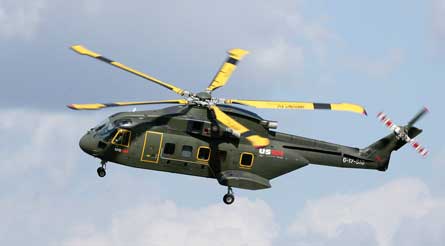AgustaWestland has flown an improved main rotor blade on the EH101, just days after its partner on the US101 programme, Lockheed Martin, submitted its final proposal for the US Air Force’s CSAR-X combat search-and-rescue helicopter. Boeing and Sikorsky also submitted bids for the 141-aircraft CSAR-X programme, with award of a contract expected by mid-November.
An EH101 flew for the first time on 26 September equipped with BERP IV blades developed under the British Experimental Rotor Programme. Later that day the helicopter, powered by uprated General Electric CT7-8E engines, reached 135kt (250kt) on its second flight. Jointly funded by the UK Ministry of Defence and AgustaWestland, the BERP IV technology demonstration aims to reduce vibration, increase performance, reduce cost, improve damage tolerance and reduce signature.
BERP IV blades and more-powerful, 2,530shp (11,880kW) CT7-8E engines will be used on the VH-71A version of the US101 under development for Increment 1 of the US presidential helicopter programme. The US101 configuration offered for CSAR-X also uses the new blades, coupled with a 3,000shp version of the CT7 being developed for the Increment 2 VH-71. Flight testing of the bigger engine will begin in the first quarter of next year, says Lockheed.
|
|---|
Lockheed is bidding the US101 in the USAF's CSAR-X contest |
The USAF is targeting an initial operational capability in the fourth quarter of 2012 for CSAR-X. Lockheed and Sikorsky are also eyeing a separate, as yet unfunded air force requirement for 71 helicopters to replace Bell UH-1 Hueys used for missile site support and VIP transport.
Source: Flight International














